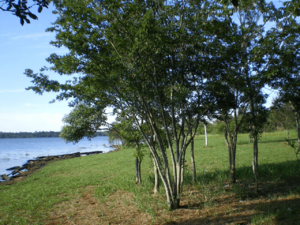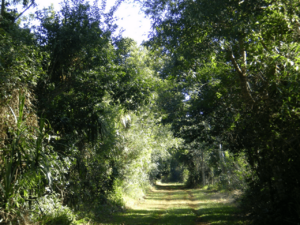Pikyry Refuge facts for kids
Pikyry is a special nature area, also called a biological reserve, in Paraguay. It's located in the Alto Paraná Department, right next to the Paraná River. Pikyry is one of eight important nature spots protected by the Itaipu Dam, which is the biggest working dam in the world! This huge dam sits between Paraguay and Brazil.
Pikyry is found in a natural bay where a small stream meets the Paraná River. This beautiful reserve covers a large area of 1,110 hectares, which is like 2,743 football fields!
Contents
Geography and Climate
Land and Soil
The land in Pikyry is mostly flat. It gently slopes down towards the big lake (reservoir) created by the Itaipu Dam in 1982. The soil here is mostly made of clay, known as latosoles. This soil has lots of good stuff from plants, making it very rich, though it's a little bit acidic. You can also find a few wet soils, like gley and humic planosoles, in some spots.
This area is super important for protecting nature. It helps connect other big protected places, like the Mbaracayu Biological Reserve and the Tatí Yupí Refuge.
Weather in Pikyry
Pikyry has a warm, subtropical climate. It gets lots of rain, usually between 1,500 and 1,700 millimeters every year. The average temperature is about 21 to 22 degrees Celsius. In winter, the temperature can change a lot between day and night. The air is quite humid, usually 70 to 80 percent. The winds mostly blow from the northeast and southeast, making the area feel pleasant.
Animals and Plants
Amazing Plants
Pikyry is home to many different kinds of plants. You'll find tall trees like Tabebuia, Cedrela fissilis, and Patagonula American. There are also many plants from the Lauraceae family. The ground is covered with smaller plants, called undergrowth, including species like Piperaceae, Bromeliaceae, Rubiaceae, pteridophytes (ferns), and Poaceae (grasses).
About 300 meters inside the reserve, there's a special type of palm tree called Trithrinax brasiliensis. This is the only place in this part of Paraguay where this particular palm tree has been found!
Wildlife in Pikyry
The reserve is full of amazing animals! You can spot many different kinds of mammals, birds, and reptiles. Some of the mammals you might see include the capybara (Hydrochaeris hydrochaeris), which is the largest rodent in the world. There are also monkeys (Cebus apella) and coatis (Nasua nasua), which are related to raccoons.
How Pikyry is Organized
The Pikyry biological reserve is divided into different sections. This helps people manage the area properly and protect it.
- Special Use Areas: These are places needed for running the reserve. They include offices, places for staff to stay, restaurants, and even a small airstrip.
- Extensive Use Zones: These are areas where visitors can go to learn and have fun. They are great for educational trips and enjoying nature.
- Intensive Zones: These spots have amazing views and can handle lots of visitors. They are perfect for activities like camping, visiting special centers, and enjoying scenic lookouts.
- Buffer Zones and Recovery Areas: These are parts of the reserve that might have been damaged, especially near busy towns. They are being protected and helped to recover.
- Core Zone: These are the most natural parts of the reserve. They have been touched very little by humans and are home to unique features of the area.
Pikyry also has a fantastic viewpoint where you can see most of the forest and the huge lake created by the dam. All the plants, water, and the shape of the land make this place incredibly valuable and beautiful.
See also
 In Spanish: Áreas silvestres protegidas de Itaipú para niños
In Spanish: Áreas silvestres protegidas de Itaipú para niños




